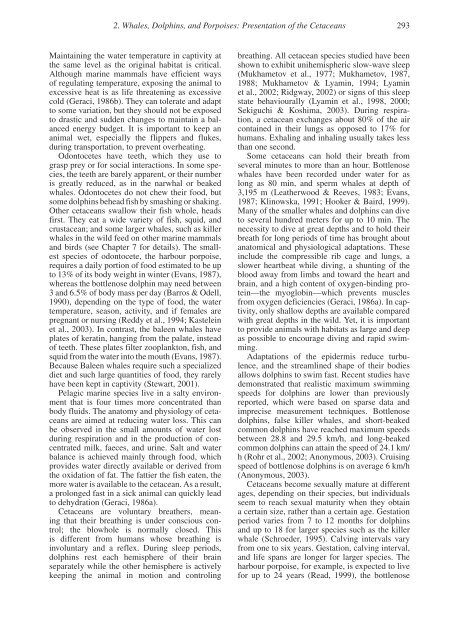Special Issue Survey of Cetaceans in Captive Care
Special Issue Survey of Cetaceans in Captive Care
Special Issue Survey of Cetaceans in Captive Care
Create successful ePaper yourself
Turn your PDF publications into a flip-book with our unique Google optimized e-Paper software.
2. Whales, Dolph<strong>in</strong>s, and Porpoises: Presentation <strong>of</strong> the <strong>Cetaceans</strong> 293Ma<strong>in</strong>ta<strong>in</strong><strong>in</strong>g the water temperature <strong>in</strong> captivity atthe same level as the orig<strong>in</strong>al habitat is critical.Although mar<strong>in</strong>e mammals have efficient ways<strong>of</strong> regulat<strong>in</strong>g temperature, expos<strong>in</strong>g the animal toexcessive heat is as life threaten<strong>in</strong>g as excessivecold (Geraci, 1986b). They can tolerate and adaptto some variation, but they should not be exposedto drastic and sudden changes to ma<strong>in</strong>ta<strong>in</strong> a balancedenergy budget. It is important to keep ananimal wet, especially the flippers and flukes,dur<strong>in</strong>g transportation, to prevent overheat<strong>in</strong>g.Odontocetes have teeth, which they use tograsp prey or for social <strong>in</strong>teractions. In some species,the teeth are barely apparent, or their numberis greatly reduced, as <strong>in</strong> the narwhal or beakedwhales. Odontocetes do not chew their food, butsome dolph<strong>in</strong>s behead fish by smash<strong>in</strong>g or shak<strong>in</strong>g.Other cetaceans swallow their fish whole, headsfirst. They eat a wide variety <strong>of</strong> fish, squid, andcrustacean; and some larger whales, such as killerwhales <strong>in</strong> the wild feed on other mar<strong>in</strong>e mammalsand birds (see Chapter 7 for details). The smallestspecies <strong>of</strong> odontocete, the harbour porpoise,requires a daily portion <strong>of</strong> food estimated to be upto 13% <strong>of</strong> its body weight <strong>in</strong> w<strong>in</strong>ter (Evans, 1987),whereas the bottlenose dolph<strong>in</strong> may need between3 and 6.5% <strong>of</strong> body mass per day (Barros & Odell,1990), depend<strong>in</strong>g on the type <strong>of</strong> food, the watertemperature, season, activity, and if females arepregnant or nurs<strong>in</strong>g (Reddy et al., 1994; Kastele<strong>in</strong>et al., 2003). In contrast, the baleen whales haveplates <strong>of</strong> kerat<strong>in</strong>, hang<strong>in</strong>g from the palate, <strong>in</strong>stead<strong>of</strong> teeth. These plates filter zooplankton, fish, andsquid from the water <strong>in</strong>to the mouth (Evans, 1987).Because Baleen whales require such a specializeddiet and such large quantities <strong>of</strong> food, they rarelyhave been kept <strong>in</strong> captivity (Stewart, 2001).Pelagic mar<strong>in</strong>e species live <strong>in</strong> a salty environmentthat is four times more concentrated thanbody fluids. The anatomy and physiology <strong>of</strong> cetaceansare aimed at reduc<strong>in</strong>g water loss. This canbe observed <strong>in</strong> the small amounts <strong>of</strong> water lostdur<strong>in</strong>g respiration and <strong>in</strong> the production <strong>of</strong> concentratedmilk, faeces, and ur<strong>in</strong>e. Salt and waterbalance is achieved ma<strong>in</strong>ly through food, whichprovides water directly available or derived fromthe oxidation <strong>of</strong> fat. The fattier the fish eaten, themore water is available to the cetacean. As a result,a prolonged fast <strong>in</strong> a sick animal can quickly leadto dehydration (Geraci, 1986a).<strong>Cetaceans</strong> are voluntary breathers, mean<strong>in</strong>gthat their breath<strong>in</strong>g is under conscious control;the blowhole is normally closed. Thisis different from humans whose breath<strong>in</strong>g is<strong>in</strong>voluntary and a reflex. Dur<strong>in</strong>g sleep periods,dolph<strong>in</strong>s rest each hemisphere <strong>of</strong> their bra<strong>in</strong>separately while the other hemisphere is activelykeep<strong>in</strong>g the animal <strong>in</strong> motion and control<strong>in</strong>gbreath<strong>in</strong>g. All cetacean species studied have beenshown to exhibit unihemispheric slow-wave sleep(Mukhametov et al., 1977; Mukhametov, 1987,1988; Mukhametov & Lyam<strong>in</strong>, 1994; Lyam<strong>in</strong>et al., 2002; Ridgway, 2002) or signs <strong>of</strong> this sleepstate behaviourally (Lyam<strong>in</strong> et al., 1998, 2000;Sekiguchi & Koshima, 2003). Dur<strong>in</strong>g respiration,a cetacean exchanges about 80% <strong>of</strong> the airconta<strong>in</strong>ed <strong>in</strong> their lungs as opposed to 17% forhumans. Exhal<strong>in</strong>g and <strong>in</strong>hal<strong>in</strong>g usually takes lessthan one second.Some cetaceans can hold their breath fromseveral m<strong>in</strong>utes to more than an hour. Bottlenosewhales have been recorded under water for aslong as 80 m<strong>in</strong>, and sperm whales at depth <strong>of</strong>3,195 m (Leatherwood & Reeves, 1983; Evans,1987; Kl<strong>in</strong>owska, 1991; Hooker & Baird, 1999).Many <strong>of</strong> the smaller whales and dolph<strong>in</strong>s can diveto several hundred meters for up to 10 m<strong>in</strong>. Thenecessity to dive at great depths and to hold theirbreath for long periods <strong>of</strong> time has brought aboutanatomical and physiological adaptations. These<strong>in</strong>clude the compressible rib cage and lungs, aslower heartbeat while div<strong>in</strong>g, a shunt<strong>in</strong>g <strong>of</strong> theblood away from limbs and toward the heart andbra<strong>in</strong>, and a high content <strong>of</strong> oxygen-b<strong>in</strong>d<strong>in</strong>g prote<strong>in</strong>—themyoglob<strong>in</strong>—which prevents musclesfrom oxygen deficiencies (Geraci, 1986a). In captivity,only shallow depths are available comparedwith great depths <strong>in</strong> the wild. Yet, it is importantto provide animals with habitats as large and deepas possible to encourage div<strong>in</strong>g and rapid swimm<strong>in</strong>g.Adaptations <strong>of</strong> the epidermis reduce turbulence,and the streaml<strong>in</strong>ed shape <strong>of</strong> their bodiesallows dolph<strong>in</strong>s to swim fast. Recent studies havedemonstrated that realistic maximum swimm<strong>in</strong>gspeeds for dolph<strong>in</strong>s are lower than previouslyreported, which were based on sparse data andimprecise measurement techniques. Bottlenosedolph<strong>in</strong>s, false killer whales, and short-beakedcommon dolph<strong>in</strong>s have reached maximum speedsbetween 28.8 and 29.5 km/h, and long-beakedcommon dolph<strong>in</strong>s can atta<strong>in</strong> the speed <strong>of</strong> 24.1 km/h (Rohr et al., 2002; Anonymous, 2003). Cruis<strong>in</strong>gspeed <strong>of</strong> bottlenose dolph<strong>in</strong>s is on average 6 km/h(Anonymous, 2003).<strong>Cetaceans</strong> become sexually mature at differentages, depend<strong>in</strong>g on their species, but <strong>in</strong>dividualsseem to reach sexual maturity when they obta<strong>in</strong>a certa<strong>in</strong> size, rather than a certa<strong>in</strong> age. Gestationperiod varies from 7 to 12 months for dolph<strong>in</strong>sand up to 18 for larger species such as the killerwhale (Schroeder, 1995). Calv<strong>in</strong>g <strong>in</strong>tervals varyfrom one to six years. Gestation, calv<strong>in</strong>g <strong>in</strong>terval,and life spans are longer for larger species. Theharbour porpoise, for example, is expected to livefor up to 24 years (Read, 1999), the bottlenose


